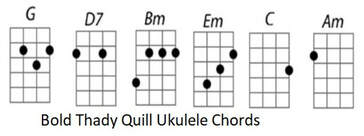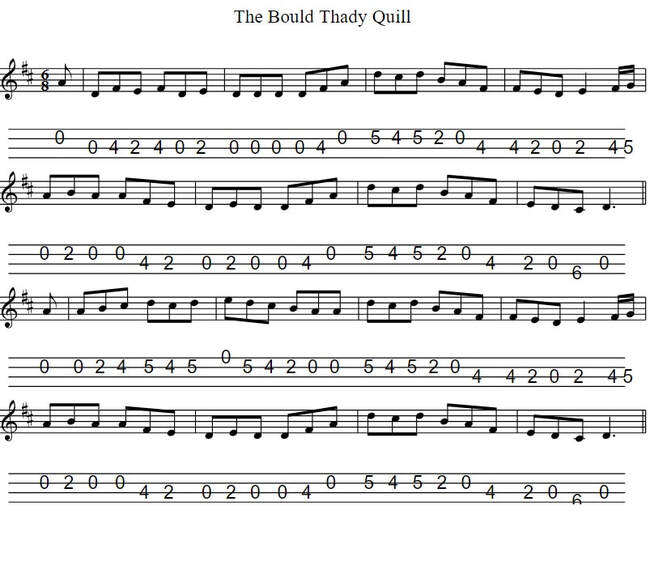Bold Thady Quill, Irish Song Lyrics And Chords
Bold Thady Quill, Irish Folk Song Written by Sean Gleeson around 1905 and brought back by The Clancys brothers and Tommy Makem. Later recorded by Irish country singer Declan Nerney who went on to record Lovely Derry On The Banks Of The Foyle , and by Annmarie O'Roirdan. The youtube video is by The Clancy Brothers. The ukulele chords are included.The bold Thady Quill tin whistle sheet music notes and mandolin tab NOW ADDED.
[C]Ye maids of Dunhallow who're anxious for courting
A [Am]word of ad[Em]vice I will[Dm] give unto[G7] ye:
Pro[C]ceed to Banteer, to the athletic[Am] sporting
And[F] hand in your[C] name to the[G7] club commit[C]tee.
But do not com[Am]mence any[Dm] sketch of your[C] progress
till a[Am] carriage ye see[Em] comin' [Dm]over the[G7] hill,
AndC] down through the valleys and glens of Kil[Am]corney
With that[F] Muskerry[C] sportsman, theG7] bold Thady[C] Quill
cho:[C] For ramblin', for rovin', for football or courtin'
For[Am] drinkin' strong[Em] liquor as[F] fast as you[G7] fill;
In all your[C] days rovin', you'll find none so[Am] jovial
As the[F] Muskerry]C] sportsman, the[G7] bold Thady[C] Quill.
Thady was famous in many other places;
At the athletic meeting held out in Cloghroe
He won the long jump without throwing off his braces
Goin' fifty=four feet every sweep he woultd throw.
At the pullin' o' the weight there was a Dublin man foremost
But Thady outreached and exceeded him still
And around the whole field rang the wild ringing chorus
"Here's luck to our hero! the bold Thady Quill."
At the great hurlin' match between Cork and Tipperary
'Twas played in the park by the banks of the Lee
Our own darlin' boys were afraid of being baten,
So they send for bold Thady to Ballinagree. '
He hurled the ball left and right in their faces
And show'd those Tipp'rary boys learnin' and skill
If they came in this way, shure he surely would brain' em
And the papers full of the praise for Thade Quill.
In the year ninety-one before Parnell was taken,
Thade was outrageously breaking the peace
He got a light sentence for causin' commotion,
And six months hard labour for batin' police.
But in spite of coercion he's still agitatin'
Ev'ry drop of his life's blood he's willing to spill,
To gain for old Ireland complete liberation,
"Till then there's no rest for me" says bold Thady Quill
At the Cork Exhibition there was a fair lady,
Whose fortune exceeded a million or more;
But a bad constitution had ruined her completely,
And medical treatment had failed o'er and o'er.
"Oh Mama" said she, I know what'll cure me
And all me diseases most certainly kill,
Give over your doctors and medical treatment,
I'd rather one squeeze outa bold Thady Quill.
A [Am]word of ad[Em]vice I will[Dm] give unto[G7] ye:
Pro[C]ceed to Banteer, to the athletic[Am] sporting
And[F] hand in your[C] name to the[G7] club commit[C]tee.
But do not com[Am]mence any[Dm] sketch of your[C] progress
till a[Am] carriage ye see[Em] comin' [Dm]over the[G7] hill,
AndC] down through the valleys and glens of Kil[Am]corney
With that[F] Muskerry[C] sportsman, theG7] bold Thady[C] Quill
cho:[C] For ramblin', for rovin', for football or courtin'
For[Am] drinkin' strong[Em] liquor as[F] fast as you[G7] fill;
In all your[C] days rovin', you'll find none so[Am] jovial
As the[F] Muskerry]C] sportsman, the[G7] bold Thady[C] Quill.
Thady was famous in many other places;
At the athletic meeting held out in Cloghroe
He won the long jump without throwing off his braces
Goin' fifty=four feet every sweep he woultd throw.
At the pullin' o' the weight there was a Dublin man foremost
But Thady outreached and exceeded him still
And around the whole field rang the wild ringing chorus
"Here's luck to our hero! the bold Thady Quill."
At the great hurlin' match between Cork and Tipperary
'Twas played in the park by the banks of the Lee
Our own darlin' boys were afraid of being baten,
So they send for bold Thady to Ballinagree. '
He hurled the ball left and right in their faces
And show'd those Tipp'rary boys learnin' and skill
If they came in this way, shure he surely would brain' em
And the papers full of the praise for Thade Quill.
In the year ninety-one before Parnell was taken,
Thade was outrageously breaking the peace
He got a light sentence for causin' commotion,
And six months hard labour for batin' police.
But in spite of coercion he's still agitatin'
Ev'ry drop of his life's blood he's willing to spill,
To gain for old Ireland complete liberation,
"Till then there's no rest for me" says bold Thady Quill
At the Cork Exhibition there was a fair lady,
Whose fortune exceeded a million or more;
But a bad constitution had ruined her completely,
And medical treatment had failed o'er and o'er.
"Oh Mama" said she, I know what'll cure me
And all me diseases most certainly kill,
Give over your doctors and medical treatment,
I'd rather one squeeze outa bold Thady Quill.






